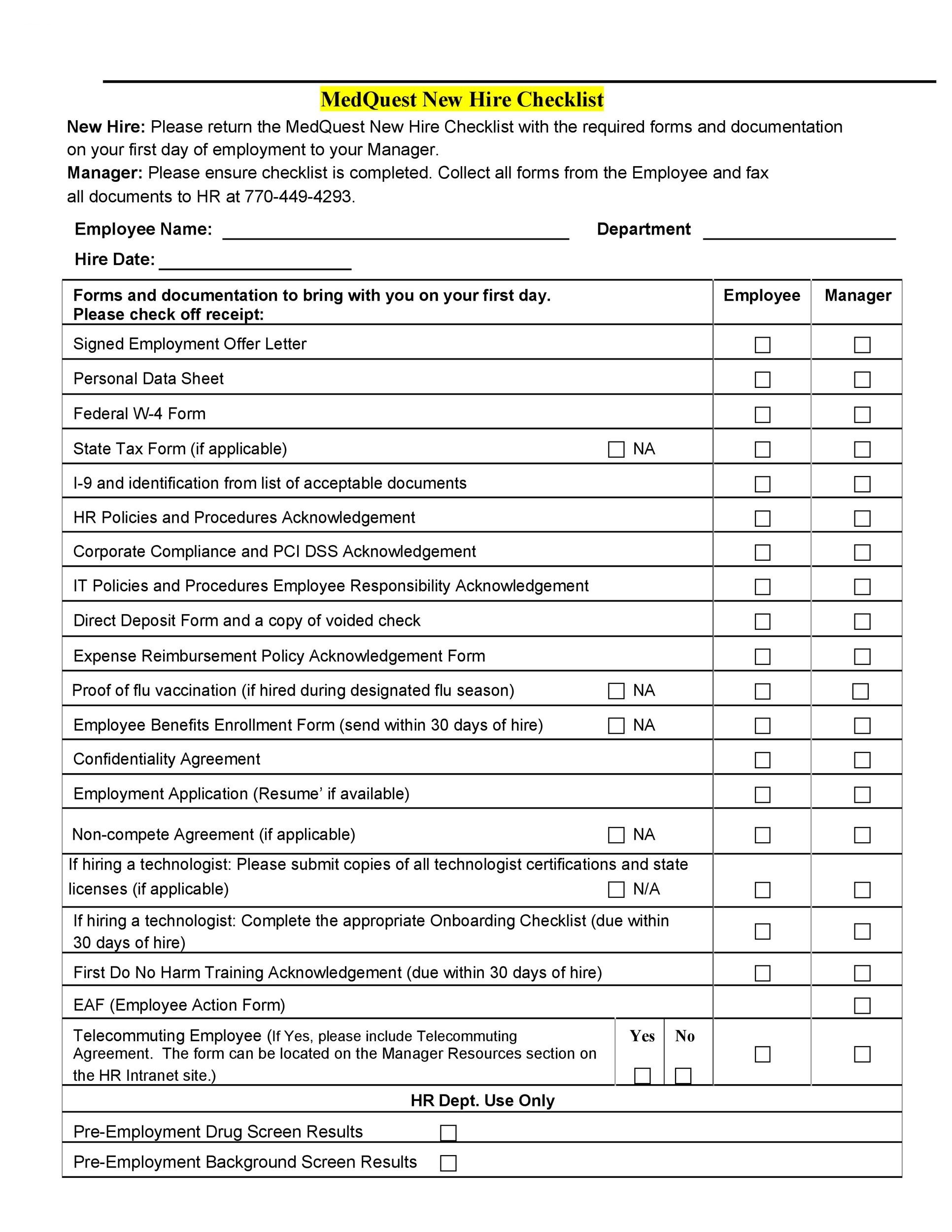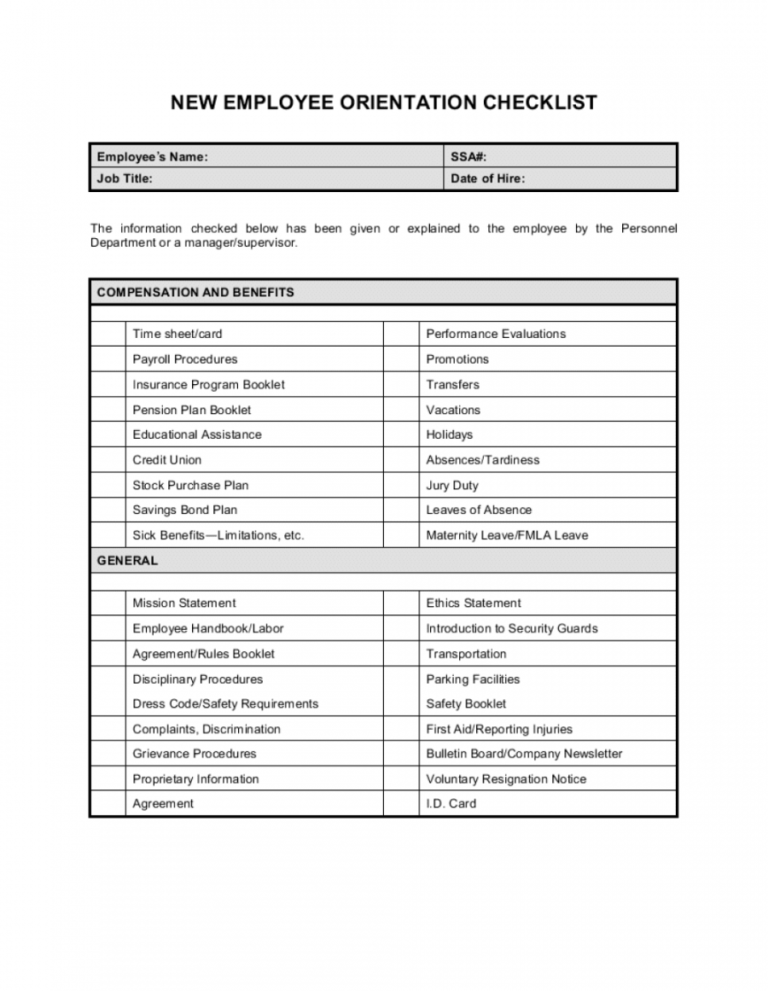
Whether you are a small business owner or an HR professional, ensuring a smooth and efficient orientation process is crucial for the success of your new hires. A well-structured new employee orientation checklist can help you streamline the onboarding process, saving time and ensuring that no important steps are missed.
In this article, we will provide you with a new employee orientation checklist that covers all the essential aspects of onboarding. From paperwork and training to company culture and team introductions, this comprehensive checklist will guide you through each step of the process. So, let’s dive in!
Why is a New Employee Orientation Checklist Important?
Starting a new job can be overwhelming for new employees. They may feel anxious and unsure about what to expect. A well-designed orientation checklist can alleviate these concerns by providing a clear roadmap of what needs to be done and when. It ensures that all necessary tasks are completed and helps new hires feel supported and welcomed from day one.
Additionally, an orientation checklist helps the HR team and managers stay organized and consistent in their onboarding efforts. It ensures that no crucial steps are overlooked, minimizing the risk of errors or omissions that could negatively impact the employee’s experience and performance.
Now that we understand the importance of a new employee orientation checklist, let’s explore the different sections and items you should include in yours.




Preparing for the Arrival of the New Employee
Before the new employee’s first day, several tasks need to be completed to ensure a smooth transition. This section focuses on the essential preparations that should be made before their arrival.
1. Schedule the Orientation
Coordinate with the new employee and relevant team members to determine the date and time for the orientation. Ensure that the necessary resources and materials are available for a productive session.
2. Prepare the Workspace
Make sure the new employee’s workspace is clean, organized, and equipped with all the necessary tools, equipment, and supplies they will need to perform their job effectively.
3. Set Up Technology and Accounts
Arrange for the new employee to have access to the required technology, including computers, software, email accounts, and any other systems they will need to use. Ensure that all accounts are set up and ready for their first day.
4. Notify the Team
Inform the existing team members about the new employee’s arrival. Share relevant details, such as their name, position, and start date, to facilitate a warm welcome.
First Day Orientation
The first day is crucial for setting the tone and welcoming the new employee to the company. This section focuses on the activities and information that should be covered on their first day.
1. Welcome and Introductions
Start the day by personally welcoming the new employee and introducing them to the team. Provide an overview of the company’s mission, values, and culture to help them feel connected and aligned with the organization.
2. Office Tour
Take the new employee on a tour of the office, introducing them to key areas such as their workspace, break rooms, meeting rooms, and other facilities. Familiarize them with the layout and amenities to help them feel comfortable in their new environment.
3. Company Policies and Procedures
Review the company’s policies and procedures, including important HR-related information such as attendance, time-off requests, dress code, and confidentiality agreements. Provide them with any necessary forms or documents to complete.
4. Job Expectations and Responsibilities
Communicate the new employee’s job expectations, responsibilities, and performance goals. Discuss their role within the team and provide any specific instructions or guidelines they need to follow.
5. Training and Development
Outline the training and development opportunities available to the new employee. Discuss any mandatory training programs, provide access to relevant resources, and explain how they can further enhance their skills and knowledge.
6. Introduction to Team Members
Arrange for the new employee to meet their immediate team members and key stakeholders. Encourage informal conversations and facilitate relationship-building to foster a sense of belonging and collaboration.
7. Employee Handbook and Benefits
Provide the new employee with a copy of the employee handbook, explaining its contents and emphasizing important policies and benefits. Discuss any questions they may have and ensure they understand their rights and entitlements.
8. Q&A Session
Allocate time for the new employee to ask questions and seek clarifications about their role, the company, or any other concerns they may have. Encourage open communication and address any queries to ensure their full understanding.
Beyond the First Day
The onboarding process extends beyond the first day and should continue for several weeks or months. This section focuses on the ongoing activities and support that should be provided to the new employee during their initial period.
1. Mentorship and Buddy System
Assign a mentor or buddy to the new employee who can provide guidance, support, and assistance during their initial period. Encourage regular check-ins and create opportunities for the new employee to learn from experienced colleagues.
2. Training and Development Plan
Create a personalized training and development plan for the new employee, outlining the specific skills and knowledge they need to acquire. Set clear milestones and objectives to track their progress and ensure a smooth integration into their role.
3. Performance Feedback and Evaluation
Regularly provide constructive feedback and evaluation to the new employee to help them understand their strengths, areas for improvement, and progress towards their goals. Schedule formal performance reviews to discuss their performance and address any concerns.
4. Team Building and Social Events
Organize team-building activities and social events to foster a sense of camaraderie and collaboration among the employees. Encourage participation and create opportunities for the new employee to connect with their colleagues on a personal level.
5. Check-In Meetings
Schedule regular check-in meetings with the new employee to discuss their experience, address any challenges, and provide additional support if needed. Use these meetings to gauge their satisfaction and ensure their smooth transition into the company.
6. Ongoing Communication
Maintain open lines of communication with the new employees, ensuring they feel comfortable reaching out for assistance or guidance. Regularly update them on company news, changes, and upcoming events to keep them engaged and informed.
7. Celebrate Milestones
Recognize and celebrate the new employee’s achievements and milestones during their onboarding journey. Acknowledge their progress and contributions to boost morale and motivate them to continue excelling in their role.
8. Evaluation and Continuous Improvement
Periodically evaluate the effectiveness of your new employee orientation checklist and onboarding process. Collect feedback from new hires and team members to identify areas for improvement and implement necessary changes to enhance the onboarding experience.
Conclusion
A well-designed and comprehensive new employee orientation checklist is an invaluable tool for ensuring a successful onboarding process. By following the steps outlined in this checklist, you can provide new hires with the support, information, and resources they need to thrive in their new role. Remember, effective onboarding is not just a one-day event; it is an ongoing process that requires continuous effort and attention. Invest in your employees’ success from the start, and you will reap the benefits of a motivated and engaged workforce.
Key Components of a Successful Onboarding Process
Creating a successful onboarding process goes beyond just having a checklist. It involves considering various components that contribute to the overall effectiveness of the orientation. Let’s explore some key components that should be integrated into your onboarding process.
1. Clear Communication and Expectations
Effective communication is essential during the onboarding process. Communicate the company’s values, mission, and vision to new employees. Set expectations for their role, performance, and behavior, ensuring they understand what is required of them from the start.
2. Comprehensive Training Programs
Develop comprehensive training programs that cover both technical skills and company-specific knowledge. Provide new employees with the necessary tools, resources, and training materials to help them quickly become productive and confident in their roles.
3. Supportive Mentoring and Coaching
Assign a mentor or coach to new employees to guide them through the onboarding process. This mentor should be someone experienced in the company and their specific role, who can provide support, answer questions, and offer advice as needed.
4. Integration into Company Culture
Ensure new employees feel welcomed and integrated into the company culture. This can involve organizing team-building activities, and social events, and providing opportunities for new hires to connect with their colleagues on a personal level.
5. Continuous Feedback and Evaluation
Regularly provide feedback and evaluate the performance of new employees. This helps them understand their strengths, areas for improvement, and how they are progressing in their role. Constructive feedback and recognition are crucial for their development and motivation.
6. Personalized Development Plans
Create personalized development plans for new employees that outline their growth opportunities within the company. This can include identifying training programs, workshops, or certifications that align with their career goals and aspirations.
7. Ongoing Support and Resources
Ensure new employees have access to the necessary resources and support they need to succeed. This can include providing them with a mentor, assigning them a point of contact for any questions or concerns, and regularly checking in on their progress.
8. Evaluation and Continuous Improvement
Regularly evaluate the effectiveness of your onboarding process and make adjustments as needed. Collect feedback from new hires and team members to identify areas for improvement and implement changes that will enhance the onboarding experience in the future.
Bottom Line
Implementing a comprehensive new employee orientation checklist is a crucial step toward creating a successful onboarding process. By following the steps outlined in this article and incorporating the key components discussed, you can ensure your new hires have a smooth transition into the company and feel supported from day one.
Remember, onboarding is not a one-size-fits-all process. Tailor your orientation checklist and activities to meet the specific needs and goals of your organization. Continuously evaluate and improve your onboarding process to provide an exceptional experience for new employees, setting them up for long-term success within your company.
New Employee Orientation Checklist Template Word – Download